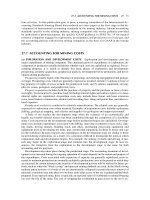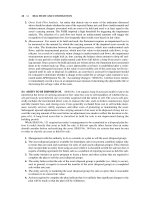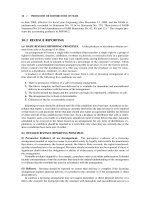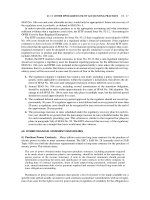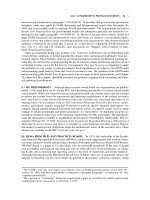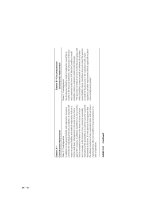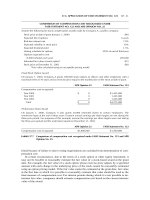Calculus: one and several variables, 10th edition
Bạn đang xem bản rút gọn của tài liệu. Xem và tải ngay bản đầy đủ của tài liệu tại đây (11.33 MB, 1,171 trang )
P1: PBU/OVY
P2: PBU/OVY
JWDD023-FM
JWDD023-Salas-v13
QC: PBU/OVY
T1: PBU
October 24, 2006
www.pdfgrip.com
17:25
P1: PBU/OVY
P2: PBU/OVY
JWDD023-FM
JWDD023-Salas-v13
QC: PBU/OVY
T1: PBU
October 24, 2006
www.pdfgrip.com
The first person to invent
a car that runs on water…
… may be sitting right in your classroom! Every
one of your students has the potential to make a
difference. And realizing that potential starts
right here, in your course.
When students succeed in your course—when
they stay on-task and make the breakthrough
that turns confusion into confidence—they are
empowered to realize the possibilities for
greatness that lie within each of them. We know your goal is to create
an environment where students reach their full potential and experience
the exhilaration of academic success that will last them a lifetime.
WileyPLUS can help you reach that goal.
WileyPLUS is an online suite of resources—including
the complete text—that will help your students:
• come to class better prepared for your lectures
• get immediate feedback and context-sensitive help on assignments
and quizzes
• track their progress throughout the course
“I just wanted to say how much this program helped me
in studying… I was able to actually see my mistakes and
correct them. … I really think that other students should
have the chance to use WileyPLUS.”
Ashlee Krisko, Oakland University
www.wiley.com/college/wileyplus
80%
of students surveyed said it improved
their understanding of the material.*
i
17:25
P1: PBU/OVY
P2: PBU/OVY
JWDD023-FM
JWDD023-Salas-v13
QC: PBU/OVY
T1: PBU
October 24, 2006
www.pdfgrip.com
FOR INSTRUCTORS
WileyPLUS is built around the activities you perform in your class each day. With WileyPLUS you can:
Prepare & Present
Create Assignments
Track Student Progress
Create outstanding class presentations
using a wealth of resources such as
PowerPoint™ slides, image galleries,
interactive simulations, and more.
You can even add materials you have
created yourself.
Automate the assigning and grading
of homework or quizzes by using the
provided question banks, or by writing
your own.
Keep track of your students' progress
and analyze individual and overall class
results.
Now Available with WebCT and Blackboard!
“It has been a great help,
and I believe it has helped
me to achieve a better
grade.”
Michael Morris,
Columbia Basin College
FOR STUDENTS
You have the potential to make a difference!
WileyPLUS is a powerful online system packed with features to help you make the most
of your potential and get the best grade you can!
With WileyPLUS you get:
• A complete online version of your text
and other study resources.
• Problem-solving help, instant grading,
and feedback on your homework and
quizzes.
• The ability to track your progress and
grades throughout the term.
For more information on what WileyPLUS can do to help you and your students reach their potential,
please visit www.wiley.com/college/wileyplus.
76%
of students surveyed said it made
them better prepared for tests. *
*Based on a survey of 972 student users of WileyPLUS
ii
17:25
P1: PBU/OVY
P2: PBU/OVY
JWDD023-FM
JWDD023-Salas-v13
QC: PBU/OVY
T1: PBU
October 24, 2006
www.pdfgrip.com
iii
17:25
P1: PBU/OVY
P2: PBU/OVY
JWDD023-FM
JWDD023-Salas-v13
QC: PBU/OVY
T1: PBU
October 24, 2006
www.pdfgrip.com
iv
17:25
P1: PBU/OVY
P2: PBU/OVY
JWDD023-FM
JWDD023-Salas-v13
QC: PBU/OVY
T1: PBU
October 24, 2006
www.pdfgrip.com
TENTH
EDITION
SALAS
HILLE
ETGEN
CALCULUS
ONE AND SEVERAL VARIABLES
JOHN WILEY & SONS, INC.
v
17:25
P1: PBU/OVY
P2: PBU/OVY
JWDD023-FM
JWDD023-Salas-v13
QC: PBU/OVY
T1: PBU
October 24, 2006
www.pdfgrip.com
In fond remembrance of
Einar Hille
ACQUISITIONS EDITOR
PUBLISHER
MARKETING MANAGER
EDITORIAL ASSISTANT
MARKETING ASSISTANT
SENIOR PRODUCTION EDITOR
DESIGNER
SENIOR MEDIA EDITOR
PRODUCTION MANAGEMENT
FREELANCE DEVELOPMENTAL EDITOR
COVER IMAGE
Mary Kittell
Laurie Rosatone
Amy Sell
Danielle Amico
Tara Martinho
Sandra Dumas
Hope Miller
Stefanie Liebman
Suzanne Ingrao
Anne Scanlan-Rohrer
Steven Puetzer/Masterfile
This book was set in New Times Roman by Techbooks, Inc. and printed and bound by Courier(Westford). The
cover was printed by Courier(Westford).
This book is printed on acid-free paper.
∞
Copyright © 2007 John Wiley & Sons, Inc. All rights reserved. No part of this publication may be reproduced,
stored in a retrieval system or transmitted in any form or by any means, electronic, mechanical, photocopying,
recording, scanning or otherwise, except as permitted under Sections 107 or 108 of the 1976 United States
Copyright Act, without either the prior written permission of the Publisher, or authorization through payment of
the appropriate per-copy fee to the Copyright Clearance Center, Inc. 222 Rosewood Drive, Danvers, MA 01923,
website www.copyright.com. Requests to the Publisher for permission should be addressed to the Permissions
Department, John Wiley & Sons, Inc., 111 River Street, Hoboken, NJ 07030-5774, (201)748-6011, fax (201)
748-6008, website />To order books or for customer service please, call 1-800-CALL WILEY (225-5945).
Library of Congress Cataloging-in-Publication Data
Salas, Saturnino L.
Calculus—10th ed/Saturnino Salas, Einar Hille, Garrett Etgen.
ISBN-13
ISBN-10
978-0471-69804-3
0-471-69804-0
Printed in the United States of America
10 9 8 7 6 5 4 3 2 1
vi
17:25
P1: PBU/OVY
P2: PBU/OVY
JWDD023-FM
JWDD023-Salas-v13
QC: PBU/OVY
T1: PBU
October 24, 2006
www.pdfgrip.com
PREFACE
This text is devoted to the study of single and multivariable calculus. While applications
from the sciences, engineering, and economics are often used to motivate or illustrate
mathematical ideas, the emphasis is on the three basic concepts of calculus: limit,
derivative, and integral.
This edition is the result of a collaborative effort with S.L. Salas, who scrutinized
every sentence for possible improvement in precision and readability. His gift for writing
and his uncompromising standards of mathematical accuracy and clarity illuminate the
beauty of the subject while increasing its accessibility to students. It has been a pleasure
for me to work with him.
FEATURES OF THE TENTH EDITION
Precision and Clarity
The emphasis is on mathematical exposition; the topics are treated in a clear and
understandable manner. Mathematical statements are careful and precise; the basic
concepts and important points are not obscured by excess verbiage.
Balance of Theory and Applications
Problems drawn from the physical sciences are often used to introduce basic concepts
in calculus. In turn, the concepts and methods of calculus are applied to a variety of
problems in the sciences, engineering, business, and the social sciences through text
examples and exercises. Because the presentation is flexible, instructors can vary the
balance of theory and applications according to the needs of their students.
Accessibility
This text is designed to be completely accessible to the beginning calculus student without sacrificing appropriate mathematical rigor. The important theorems are explained
vii
17:25
P1: PBU/OVY
P2: PBU/OVY
JWDD023-FM
JWDD023-Salas-v13
QC: PBU/OVY
T1: PBU
October 24, 2006
www.pdfgrip.com
viii ■
PREFACE
and proved, and the mathematical techniques are justified. These may be covered or
omitted according to the theoretical level desired in the course.
Visualization
The importance of visualization cannot be over-emphasized in developing students’
understanding of mathematical concepts. For that reason, over 1200 illustrations accompany the text examples and exercise sets.
Technology
The technology component of the text has been strengthened by revising existing exercises and by developing new exercises. Well over half of the exercise sets have problems
requiring either a graphing utility or a computer algebra system (CAS). Technology
exercises are designed to illustrate or expand upon the material developed within the
sections.
Projects
Projects with an emphasis on problem solving offer students the opportunity to investigate a variety of special topics that supplement the text material. The projects typically
require an approach that involves both theory and applications, including the use of
technology. Many of the projects are suitable for group-learning activities.
Early Coverage of Differential Equations
Differential equations are formally introduced in Chapter 7 in connection with applications to exponential growth and decay. First-order linear equations, separable equations,
and second linear equations with constant coefficients, plus a variety of applications,
are treated in a separate chapter immediately following the techniques of integration
material in Chapter 8.
CHANGES IN CONTENT AND ORGANIZATION
In our effort to produce an even more effective text, we consulted with the users of the
Ninth Edition and with other calculus instructors. Our primary goals in preparing the
Tenth Edition were the following:
1. Improve the exposition. As noted above, every topic has been examined for possible
improvement in the clarity and accuracy of its presentation. Essentially every section
in the text underwent some revision; a number of sections and subsections were
completely rewritten.
2. Improve the illustrative examples. Many of the existing examples have been modified to enhance students’ understanding of the material. New examples have been
added to sections that were rewritten or substantially revised.
3. Revise the exercise sets. Every exercise set was examined for balance between drill
problems, midlevel problems, and more challenging applications and conceptual
problems. In many instances, the number of routine problems was reduced and new
midlevel to challenging problems were added.
Specific changes made to achieve these goals and meet the needs of today’s students
and instructors include:
17:25
P1: PBU/OVY
P2: PBU/OVY
JWDD023-FM
JWDD023-Salas-v13
QC: PBU/OVY
T1: PBU
October 24, 2006
www.pdfgrip.com
PREFACE
Comprehensive Chapter-End Review Exercise Sets
The Skill Mastery Review Exercise Sets introduced in the Ninth Edition have been
expanded into chapter-end exercise sets. Each chapter concludes with a comprehensive
set of problems designed to test and to re-enforce students’ understanding of basic
concepts and methods developed within the chapter. These review exercise sets average
over 50 problems per set.
Precalculus Review (Chapter 1)
The content of this chapter—inequalities, basic analytic geometry, the function concept
and the elementary functions—is unchanged. However, much of the material has been
rewritten and simplified.
Limits (Chapter 2)
The approach to limits is unchanged, but many of the explanations have been revised.
The illustrative examples throughout the chapter have been modified, and new examples
have been added.
Differentiation and Applications (Chapters 3 and 4)
There are some significant changes in the organization of this material. Realizing that
our treatments of linear motion, rates of change per unit time, and the Newton-Raphson
method depended on an understanding of increasing/decreasing functions and the concavity of graphs, we moved these topics from Chapter 3 (the derivative) to Chapter 4
(applications of the derivative). Thus, Chapter 3 is now a shorter chapter which focuses
solely on the derivative and the processes of differentiation, and Chapter 4 is expanded
to encompass all of the standard applications of the derivative—curve-sketching, optimization, linear motion, rates of change, and approximation. As in all previous editions,
Chapter 4 begins with the mean-value theorem as the theoretical basis for all the applications.
Integration and Applications (Chapters 5 and 6)
In a brief introductory section, area and distance are used to motivate the definite
integral in Chapter 5. While the definition of the definite integral is based on upper and
lower sums, the connection with Riemann sums is also given. Explanations, examples,
and exercises throughout Chapters 5 and 6 have been modified, but the content and
organization remain as in the Ninth Edition.
The Transcendental Functions, Techniques of Integration
(Chapters 7 and 8)
The coverage of the inverse trigonometric functions (Chapter 7) has been reduced
slightly. The treatment of powers of the trigonometric functions (Chapter 8) has been
completely rewritten. The optional sections on first-order linear differential equations
and separable differential equations have been moved to Chapter 9, the new chapter on
differential equations.
Some Differential Equations (Chapter 9)
This new chapter is a brief introduction to differential equations and their applications.
In addition to the coverage of first-order linear equations and separable equations noted
■
ix
17:25
P1: PBU/OVY
P2: PBU/OVY
JWDD023-FM
JWDD023-Salas-v13
QC: PBU/OVY
T1: PBU
October 24, 2006
www.pdfgrip.com
x ■
PREFACE
above, we have moved the section on second-order linear homogeneous equations with
constant coefficients from the Ninth Edition’s Chapter 18 to this chapter.
Sequences and Series (Chapters 11 and 12)
Efforts were made to reduce the overall length of these chapters through rewriting
and eliminating peripheral material. Eliminating extraneous problems reduced several
exercise sets. Some notations and terminology have been modified to be consistent with
common usage.
Vectors and Vector Calculus (Chapters 13 and 14)
The introduction to vectors in three-dimensional space has been completely rewritten and reduced from two sections to one. The parallel discussion of vectors in twoand three-dimensional space has been eliminated—the primary focus is on threedimensional space. The treatments of the dot product, the cross product, lines and
planes in Chapter 13, and vector calculus in Chapter 14 are unchanged.
Functions of Several Variables, Gradients, Extreme Values
(Chapters 15 and 16); Multiple Integrals, Line and Surface Integrals
(Chapters 16 and 17)
The basic content and organization of the material in these four chapters remain as in the
ninth edition. Improvements have been made in the exposition, examples, illustrations,
and exercises.
Differential Equations (Chapter 19)
This chapter continues the study of differential equations begun in Chapter 9. The
sections on Bernoulli, homogeneous and exact equations have been rewritten, and
elementary numerical methods are now covered in a separate section. The section on
second-order linear nonhomogeneous equations picks up from the treatment of linear
homogeneous equations in the new Chapter 9. The applications section—vibrating
mechanical systems—is unchanged.
SUPPLEMENTS
An Instructor’s Solutions Manual, ISBN 0470127309, includes solutions for all problems in the text.
A Student Solutions Manual, ISBN 0470105534, includes solutions for selected problems in the text.
A Companion Web site, www.wiley.com/college/salas, provides a wealth of resources
for students and instructors, including:
• PowerPoint Slides for important ideas and graphics for study and note taking.
• Online Review Quizzes to enable students to test their knowledge of key concepts.
For further review diagnostic feedback is provided that refers to pertinent sections of
the text.
• Animations comprise a series of interactive Java applets that allow students to explore
the geometric significance of many major concepts of Calculus.
• Algebra and Trigonometry Refreshers is a self-paced, guided review of key algebra
and trigonometry topics that are essential for mastering calculus.
17:25
P1: PBU/OVY
P2: PBU/OVY
JWDD023-FM
JWDD023-Salas-v13
QC: PBU/OVY
T1: PBU
October 24, 2006
www.pdfgrip.com
PREFACE
• Personal Response System Questions provide a convenient source of questions to
use with a variety of personal response systems.
• Printed Test Bank contains static tests which can be printed for quick tests.
• Computerized Test Bank includes questions from the printed test bank with algorithmically generated problems.
WILEYPLUS
Expect More from Your Classroom Technology
This text is supported by WileyPLUS—a powerful and highly integrated suite of teaching and learning resources designed to bridge the gap between what happens in the
classroom and what happens at home. WileyPLUS includes a complete online version
of the text, algorithmically generated exercises, all of the text supplements, plus course
and homework management tools, in one easy-to-use website.
Organized Around the Everyday Activities You Perform in Class,
WileyPLUS Helps You:
Prepare and present: WileyPLUS lets you create class presentations quickly and
easily using a wealth of Wiley-provided resources, including an online version of the
textbook, PowerPoint slides, and more. You can adapt this content to meet the needs
of your course.
Create assignments: WileyPLUS enables you to automate the process of assigning
and grading homework or quizzes. You can use algorithmically generated problems
from the text’s accompanying test bank, or write your own.
Track student progress: An instructor’s grade book allows you to analyze individual
and overall class results to determine students’ progress and level of understanding.
Promote strong problem-solving skills: WileyPLUS can link homework problems to
the relevant section of the online text, providing students with context-sensitive help.
WileyPLUS also features mastery problems that promote conceptual understanding
of key topics and video walkthroughs of example problems.
Provide numerous practice opportunities: Algorithmically generated problems provide unlimited self-practice opportunities for students, as well as problems for homework and testing.
Support varied learning styles: WileyPLUS includes the entire text in digital format,
enhanced with varied problem types to support the array of different student learning
styles in today’s classroom.
Administer your course: You can easily integrate WileyPLUS with another course
management system, grade books, or other resources you are using in your class,
enabling you to build your course your way.
WileyPLUS Includes A Wealth of Instructor and Student Resources:
Student Solutions Manual: Includes worked-out solutions for all odd-numbered problems and study tips.
Instructor’s Solutions Manual: Presents worked out solutions to all problems.
PowerPoint Lecture Notes: In each section of the book a corresponding set of lecture
notes and worked out examples are presented as PowerPoint slides that are tied to
the examples in the text.
■
xi
17:25
P1: PBU/OVY
P2: PBU/OVY
JWDD023-FM
JWDD023-Salas-v13
QC: PBU/OVY
T1: PBU
October 24, 2006
www.pdfgrip.com
xii ■
PREFACE
View an online demo at www.wiley.com/college/wileyplus or contact your local
Wiley representative for more details.
The Wiley Faculty Network—Where Faculty Connect
The Wiley Faculty Network is a faculty-to-faculty network promoting the effective use
of technology to enrich the teaching experience. The Wiley Faculty Network facilitates
the exchange of best practices, connects teachers with technology, and helps to enhance
instructional efficiency and effectiveness. The network provides technology training
and tutorials, including WileyPLUS training, online seminars, peer-to-peer exchanges
of experiences and ideas, personalized consulting, and sharing of resources.
Connect with a Colleague
Wiley Faculty Network mentors are faculty like you, from educational institutions
around the country, who are passionate about enhancing instructional efficiency and
effectiveness through best practices. You can engage a faculty mentor in an online
conversation at www.wherefacultyconnect.com.
Connect with the Wiley Faculty Network
Web: www.wherefacultyconnect.com
Phone: 1-866-FACULTY
ACKNOWLEDGMENTS
The revision of a text of this magnitude and stature requires a lot of encouragement
and help. I was fortunate to have an ample supply of both from many sources. The
present book owes much to the people who contributed to the first nine editions, most
recently: Omar Adawi, Parkland College; Mihaly Bakonyi, Georgia State University;
Edward B. Curtis, University of Washington; Boris A. Datskovsky, Temple University;
Kathy Davis University of Texas-Austin; Dennis DeTurck, University of Pennsylvania; John R. Durbin, University of Texas-Austin; Ronald Gentle, Eastern Washington
University; Robert W. Ghrist, Georgia Institute of Technology; Charles H. Giffen, University of Virginia–Charlottesville; Michael Kinyon, Indiana University-South Bend;
Susan J. Lamon, Marquette University; Peter A. Lappan, Michigan State University;
Nicholas Macri, Temple University; James Martino, Johns Hopkins University; James
R. McKinney, California State Polytechnic University-Pomona; Jeff Morgan, Texas A
& M University; Peter J. Mucha, Georgia Institute of Technology; Elvira Munoz-Garcia,
University of California, Los Angeles; Ralph W. Oberste-Vorth, University of South
Florida; Charles Odion, Houston Community College; Charles Peters, University of
Houston; Clifford S. Queen, Lehigh University; J. Terry Wilson, San Jacinto College
Central and Yang Wang, Georgia Institute of Technology. I am deeply indebted to all
of them.
The reviewers and contributors to the Tenth Edition supplied detailed criticisms
and valuable suggestions. I offer my sincere appreciation to the following individuals:
Omar Adawi,
Parkland College
Ulrich Albrecht,
Auburn University
Joseph Borzellino,
California Polytechnic State University, San Luis Obispo
Michael R. Colvin,
The University of St. Thomas
17:25
P1: PBU/OVY
P2: PBU/OVY
JWDD023-FM
JWDD023-Salas-v13
QC: PBU/OVY
T1: PBU
October 24, 2006
www.pdfgrip.com
PREFACE
James Dare,
Nasser Dastrange,
David Dorman,
Martin E. Flashman,
David Frank,
Melanie Fulton,
Isobel Gaensler,
Frieda Ganter,
Murli M. Gupta,
Aida Kadic-Galeb,
Mohammad Ghomi,
Robert W. Ghrist,
Semion Gutman,
Rahim G. Karimpour,
Robert Keller,
Kevin P. Knudson,
Ashok Kumar,
Jeff Leader,
Xin Li,
Doron Lubinsky,
Edward T. Migliore,
Maya Mukherjee,
Sanjay Mundkur,
Michael M. Neumann,
Charles Odion,
Dan Ostrov,
Shahrokh Parvini,
Chuang Peng,
Kanishka Perera,
Denise Reid,
Paul Seeburger,
Constance Schober,
Peter Schumer,
Kimberly Shockey
Henry Smith,
James Thomas,
James L. Wang,
Ying Wang,
Charles Waters,
Mark Woodard,
Yan Wu,
Dekang Xu,
Indiana-Purdue University at Fort Wayne
Buena Vista University
Middlebury College
Humboldt State University/Occidental College
University of Minnesota
High Point University
Georgia State University
West Hills College, Lemoore
George Washington University
University of Tampa
Georgia Institute of Technology
University of Illinois, Urbana-Champaign
University of Oklahoma
Southern Illinois University- Edwardsville
Loras College
Mississippi State University
Valdosta State University
Rose-Hulman Institute of Technology
University of Central Florida
Georgia Institute of Technology
Monterey Peninsula College/University of California,
Santa Cruz
Morehouse College
Kennesaw State University
Mississippi State University
Houston Community College
Santa Clara University
San Diego Mesa College
Morehouse College
Florida Institute of Technology
Valdosta State University
Monroe Community College
University of Central Florida
Middlebury College
River Parishes Community College
Colorado State University
University of Alabama
Augusta State University
Minnesota State University, Mankato
Furman University
Georgia Southern University
University of Houston
■
xiii
17:25
P1: PBU/OVY
P2: PBU/OVY
JWDD023-FM
JWDD023-Salas-v13
QC: PBU/OVY
T1: PBU
October 24, 2006
www.pdfgrip.com
xiv ■
PREFACE
I am especially grateful to Paul Lorczak and Neil Wigley, who carefully read the
revised material. They provided many corrections and helpful comments. I would like
to thank Bill Ardis for his advice and guidance in the creation of the new technology
exercises in the text.
I am deeply indebted to the editorial staff at John Wiley & Sons. Everyone involved in this project has been encouraging, helpful, and thoroughly professional at
every stage. In particular, Laurie Rosatone, Publisher, Mary Kittell, Acquisitions
Editor, Anne Scanlan-Rohrer, Freelance Developmental Editor and Danielle Amico,
Editorial Assistant, provided organization and support when I needed it and prodding
when prodding was required. Special thanks go to Sandra Dumas, Production Editor,
and Suzanne Ingrao, Production Coordinator, who were patient and understanding as
they guided the project through the production stages; Hope Miller, Designer, whose
creativity produced the attractive interior design as well as the cover and Stefanie
Liebman, Senior Media Editor, who has produced valuable media resources to support
my text.
Finally, I want to acknowledge the contributions of my wife, Charlotte; without her
continued support, I could not have completed this work.
Garret J. Etgen
17:25
P1: PBU/OVY
P2: PBU/OVY
JWDD023-FM
JWDD023-Salas-v13
QC: PBU/OVY
T1: PBU
October 24, 2006
www.pdfgrip.com
CONTENTS
CHAPTER 1
1.1
PRECALCULUS REVIEW
1
Girth
What is Calculus? 1
th
ng
1.2 Review of Elementary Mathematics 3
Le
1.3 Review of Inequalities 11
1.4 Coordinate Plane; Analytic Geometry 17
1.5 Functions 24
1.6 The Elementary Functions 32
1.7 Combinations of Functions 41
1.8 A Note on Mathematical Proof; Mathematical Induction 47
CHAPTER 2
LIMITS AND CONTINUITY
2.1
The Limit Process (An Intuitive Introduction) 53
2.2
Definition of Limit 64
2.3
Some Limit Theorems 73
2.4
Continuity 82
2.5
The Pinching Theorem; Trigonometric Limits 91
53
y
f
L+ ε
L
L–ε
2.6 Two Basic Theorems 97
Project 2.6 The Bisection Method for Finding the Roots of f (x) = 0 102
c–δ
c
c+δ
x
xv
17:25
P1: PBU/OVY
P2: PBU/OVY
JWDD023-FM
JWDD023-Salas-v13
QC: PBU/OVY
T1: PBU
October 24, 2006
www.pdfgrip.com
xvi ■
CONTENTS
CHAPTER 3
THE DERIVATIVE; THE PROCESS OF DIFFERENTIATION 105
3.1 The Derivative 105
3.2 Some Differentiation Formulas 115
3.3 The d/dx Notation; Derivatives of Higher Order 124
3.4 The Derivative As A Rate of Change 130
3.5 The Chain Rule 133
3.6 Differentiating The Trigonometric Functions 142
3.7 Implicit Differentiation; Rational Powers 147
CHAPTER 4
THE MEAN-VALUE THEOREM; APPLICATIONS
OF THE FIRST AND SECOND DERIVATIVES
154
4.1 The Mean-Value Theorem 154
4.2 Increasing and Decreasing Functions 160
4.3 Local Extreme Values 167
4.4 Endpoint Extreme Values; Absolute Extreme Values 174
4.5 Some Max-Min Problems 182
ent
tang
Project 4.5 Flight Paths of Birds 190
l
(b,
f (b))
4.6 Concavity and Points of Inflection 190
4.7 Vertical and Horizontal Asymptotes; Vertical Tangents and Cusps 195
(a, f (a))
a
4.8 Some Curve Sketching 201
c
b
4.9 Velocity and Acceleration; Speed 209
Project 4.9A Angular Velocity; Uniform Circular Motion 217
Project 4.9B Energy of a Falling Body (Near the Surface of the Earth) 217
4.10 Related Rates of Change per Unit Time 218
4.11 Differentials 223
Project 4.11 Marginal Cost, Marginal Revenue, Marginal Profit 228
4.12 Newton-Raphson Approximations 229
CHAPTER 5
INTEGRATION
5.1 An Area Problem; a Speed-Distance Problem 234
5.2 The Definite Integral of a Continuous Function 237
x
5.3 The Function f (x) =
f (t) dt 246
a
5.4 The Fundamental Theorem of Integral Calculus 254
5.5 Some Area Problems 260
Project 5.5 Integrability; Integrating Discontinuous Functions 266
5.6 Indefinite Integrals 268
5.7 Working Back from the Chain Rule; the u-Substitution 274
5.8 Additional Properties of the Definite Integral 281
5.9 Mean-Value Theorems for Integrals; Average Value of a Function 285
234
17:25
P1: PBU/OVY
P2: PBU/OVY
JWDD023-FM
JWDD023-Salas-v13
QC: PBU/OVY
T1: PBU
October 24, 2006
www.pdfgrip.com
CHAPTER 6
SOME APPLICATIONS OF THE INTEGRAL
6.1
More on Area 292
6.2
Volume by Parallel Cross Sections; Disks and Washers 296
6.3
Volume by the Shell Method 306
6.4
The Centroid of a Region; Pappus’s Theorem on Volumes 312
xvii
■
CONTENTS
y
292
Project 6.4 Centroid of a Solid of Revolution 319
6.5
The Notion of Work 319
g(y)
*6.6 Fluid Force 327
x
CHAPTER 7
THE TRANSCENDENTAL FUNCTIONS
7.1
One-to-One Functions; Inverses 333
7.2
The Logarithm Function, Part I 342
7.3
The Logarithm Function, Part II 347
7.4
The Exponential Function 356
7.5
Arbitrary Powers; Other Bases 364
7.6
Exponential Growth and Decay 370
7.7
The Inverse Trigonometric Functions 378
333
y
f
f
Project 7.4 Some Rational Bounds for the Number e 364
–1
1
–1
f
x
1
–1
–1
Project 7.7 Refraction 387
7.8
The Hyperbolic Sine and Cosine 388
*7.9 The Other Hyperbolic Functions 392
f
CHAPTER 8
TECHNIQUES OF INTEGRATION
8.1
Integral Tables and Review 398
8.2
Integration by Parts 402
398
f
Project 8.2 Sine Waves y = sin nx and Cosine Waves y = cos nx 410
8.3
8.4
Powers and Products of Trigonometric Functions 411
√
√
√
Integrals Featuring a 2 − x 2 , a 2 + x 2 , x 2 − a 2 417
8.5
Rational Functions; Partial Fractions 422
*8.6
8.7
Some Rationalizing Substitutions 430
x
Numerical Integration 433
y
CHAPTER 9
SOME DIFFERENTIAL EQUATIONS
443
3
2
9.1
First-Order Linear Equations 444
9.2
Integral Curves; Separable Equations 451
9.3
1
−4
−2
2
Project 9.2 Orthogonal Trajectories 458
−1
The Equation y + ay + by = 0 459
−2
−3
∗
Denotes optional section.
4
x
17:25
P1: PBU/OVY
P2: PBU/OVY
JWDD023-FM
JWDD023-Salas-v13
QC: PBU/OVY
T1: PBU
October 24, 2006
www.pdfgrip.com
xviii ■
CONTENTS
CHAPTER 10
THE CONIC SECTIONS; POLAR COORDINATES;
PARAMETRIC EQUATIONS
469
10.1 Geometry of Parabola, Ellipse, Hyperbola 469
y
10.2 Polar Coordinates 478
10.3 Sketching Curves in Polar Coordinates 484
Project 10.3 Parabola, Ellipse, Hyperbola in Polar Coordinates 491
10.4 Area in Polar Coordinates 492
x
10.5 Curves Given Parametrically 496
Project 10.5 Parabolic Trajectories 503
10.6 Tangents to Curves Given Parametrically 503
10.7 Arc Length and Speed 509
10.8 The Area of A Surface of Revolution; The Centroid of a Curve; Pappus’s Theorem
on Surface Area 517
Project 10.8 The Cycloid 525
CHAPTER 11
SEQUENCES; INDETERMINATE FORMS;
IMPROPER INTEGRALS
528
y
11.1 The Least Upper Bound Axiom 528
11.2 Sequences of Real Numbers 532
11.3 Limit of a Sequence 538
Project 11.3 Sequences and the Newton-Raphson Method 547
11.4 Some Important Limits 550
x
11.5 The Indeterminate Form (0/0) 554
11.6 The Indeterminate Form (∞/∞); Other Indeterminate Forms 560
11.7 Improper Integrals 565
CHAPTER 12
y
6
12.1 Sigma Notation 575
P3(x)
f (x) = e x
12.2 Infinite Series 577
P2(x)
12.3 The Integral Test; Basic Comparison, Limit Comparison 585
5
P1(x)
4
3
12.6 Taylor Polynomials in x; Taylor Series in x 602
2
12.7 Taylor Polynomials and Taylor Series in x − a 613
1
–2
P3
–1
P1
12.4 The Root Test; the Ratio Test 593
12.5 Absolute Convergence and Conditional Convergence; Alternating Series 597
P2
–3
INFINITE SERIES
P0(x)
1
2
3
x
12.8
Power Series 616
12.9
Differentiation and Integration of Power Series 623
Project 12.9A The Binomial Series 633
Project 12.9B Estimating π 634
575
17:25
P1: PBU/OVY
P2: PBU/OVY
JWDD023-FM
JWDD023-Salas-v13
QC: PBU/OVY
T1: PBU
October 24, 2006
www.pdfgrip.com
CONTENTS
CHAPTER 13
VECTORS IN THREE-DIMENSIONAL SPACE
■
xix
638
13.1 Rectangular Space Coordinates 638
13.2 Vectors in Three-Dimensional Space 644
P3
13.3 The Dot Product 653
P
P1
Project 13.3 Work 663
13.4 The Cross Product 663
P2
13.5 Lines 671
13.6 Planes 679
Project 13.6 Some Geometry by Vector Methods 688
13.7 Higher Dimensions 689
CHAPTER 14
VECTOR CALCULUS
z
692
14.1 Limit, Continuity, Vector Derivative 694
14.2 The Rules of Differentiation 701
14.3 Curves 705
14.4 Arc Length 714
Project 14.4 More General Changes of Parameter 721
14.5 Curvilinear Motion; Curvature 723
Project 14.5A Transition Curves 732
Project 14.5B The Frenet Formulas 733
14.6 Vector Calculus in Mechanics 733
*14.7
y
Planetary Motion 741
x
CHAPTER 15
FUNCTIONS OF SEVERAL VARIABLES
748
z
15.1 Elementary Examples 748
15.2 A Brief Catalogue of the Quadric Surfaces; Projections 751
15.3 Graphs; Level Curves and Level Surfaces 758
Project 15.3 Level Curves and Surfaces 766
15.4 Partial Derivatives 767
15.5 Open and Closed Sets 774
15.6 Limits and Continuity; Equality of Mixed Partials 777
y
(0, 1, 0)
Project 15.6 Partial Differential Equations 785
x
17:25
P1: PBU/OVY
P2: PBU/OVY
JWDD023-FM
JWDD023-Salas-v13
QC: PBU/OVY
T1: PBU
October 24, 2006
www.pdfgrip.com
xx ■
CONTENTS
CHAPTER 16
z
GRADIENTS; EXTREME VALUES; DIFFERENTIALS
788
16.1 Differentiability and Gradient 788
1
16.2 Gradients and Directional Derivatives 796
16.3 The Mean-Value Theorem; the Chain Rule 805
16.4 The Gradient as a Normal; Tangent Lines and Tangent Planes 818
1
y
16.5 Local Extreme Values 828
16.6 Absolute Extreme Values 836
16.7 Maxima and Minima with Side Conditions 841
Project 16.7 Maxima and Minima with Two Side Conditions 849
16.8 Differentials 849
16.9 Reconstructing a Function from Its Gradient 855
CHAPTER 17
DOUBLE AND TRIPLE INTEGRALS
864
17.1 Multiple-Sigma Notation 864
z
17.2 Double Integrals 867
17.3 The Evaluation of Double Integrals by Repeated Integrals 878
17.4 The Double Integral as the Limit of Riemann Sums; Polar Coordinates 888
17.5 Further Applications of the Double Integral 895
17.6 Triple Integrals 902
y
17.7 Reduction to Repeated Integrals 907
17.8 Cylindrical Coordinates 916
17.9 The Triple Integral as the Limit of Riemann Sums; Spherical Coordinates 922
x
17.10 Jacobians; Changing Variables in Multiple Integration 930
Project 17.10 Generalized Polar Coordinates 935
CHAPTER 18
LINE INTEGRALS AND SURFACE INTEGRALS
938
18.1 Line Integrals 938
18.2 The Fundamental Theorem for Line Integrals 946
18.3 Work-Energy Formula; Conservation of Mechanical Energy 951
18.4 Another Notation for Line Integrals; Line Integrals with Respect to Arc Length 954
18.5 Green’s Theorem 959
T1
T2
18.6 Parametrized Surfaces; Surface Area 969
18.7 Surface Integrals 980
18.8 The Vector Differential Operator ∇ 989
18.9 The Divergence Theorem 995
Project 18.9 Static Charges 1000
18.10
Stokes’s Theorem 1001
17:25
P1: PBU/OVY
P2: PBU/OVY
JWDD023-FM
JWDD023-Salas-v13
QC: PBU/OVY
T1: PBU
October 27, 2006
www.pdfgrip.com
CONTENTS
CHAPTER 19
ADDITIONAL DIFFERENTIAL EQUATIONS
x
1.5
19.2 Exact Differential Equations; Integrating Factors 1013
1
0.5
19.3 Numerical Methods 1018
y
Project 19.3 Direction Fields 1022
0
– 0.5
19.4 The Equation y + ay + by = φ(x) 1022
–1
–1.5
19.5 Mechanical Vibrations 1030
SOME ADDITIONAL TOPICS
A-1
A.1 Rotation of Axes; Eliminating the x y-Term A-1
A.2 Determinants A-3
APPENDIX B
SOME ADDITIONAL PROOFS
B.1 The Intermediate-Value Theorem A-8
B.2 Boundedness; Extreme-Value Theorem A-9
B.3 Inverses A-10
B.4 The Integrability of Continuous Functions A-11
B.5 The Integral as the Limit of Riemann Sums A-14
ANSWERS TO ODD-NUMBERED EXERCISES A-15
Index I-1
Table of Integrals Inside Covers
xxi
1010
19.1 Bernoulli Equations; Homogeneous Equations 1010
APPENDIX A
■
A-8
y
–3
–2
–1
0
x
1
2
3
14:50
P1: PBU/OVY
P2: PBU/OVY
JWDD023-FM
JWDD023-Salas-v13
QC: PBU/OVY
T1: PBU
October 24, 2006
www.pdfgrip.com
xxii
17:25
P1: PBU/OVY
P2: PBU/OVY
JWDD023-01
JWDD023-Salas-v13
QC: PBU/OVY
T1: PBU
October 5, 2006
www.pdfgrip.com
CHAPTER
1
PRECALCULUS REVIEW
In this chapter we gather together for reference and review those parts of elementary
mathematics that are necessary for the study of calculus. We assume that you are
familiar with most of this material and that you don’t require detailed explanations. But
first a few words about the nature of calculus and a brief outline of the history of the
subject.
■ 1.1 WHAT IS CALCULUS?
To a Roman in the days of the empire, a “calculus” was a pebble used in counting and
gambling. Centuries later, “calculare” came to mean “to calculate,” “to compute,” “to
figure out.” For our purposes, calculus is elementary mathematics (algebra, geometry,
trigonometry) enhanced by the limit process.
Calculus takes ideas from elementary mathematics and extends them to a more
general situation. Some examples are on pages 2 and 3. On the left-hand side you will
find an idea from elementary mathematics; on the right, this same idea as extended by
calculus.
It is fitting to say something about the history of calculus. The origins can be traced
back to ancient Greece. The ancient Greeks raised many questions (often paradoxical)
about tangents, motion, area, the infinitely small, the infinitely large—questions that
today are clarified and answered by calculus. Here and there the Greeks themselves
provided answers (some very elegant), but mostly they provided only questions.
Elementary Mathematics
Calculus
slope of a line
y = mx + b
slope of a curve
y = f (x)
(Table continues)
1
15:42

